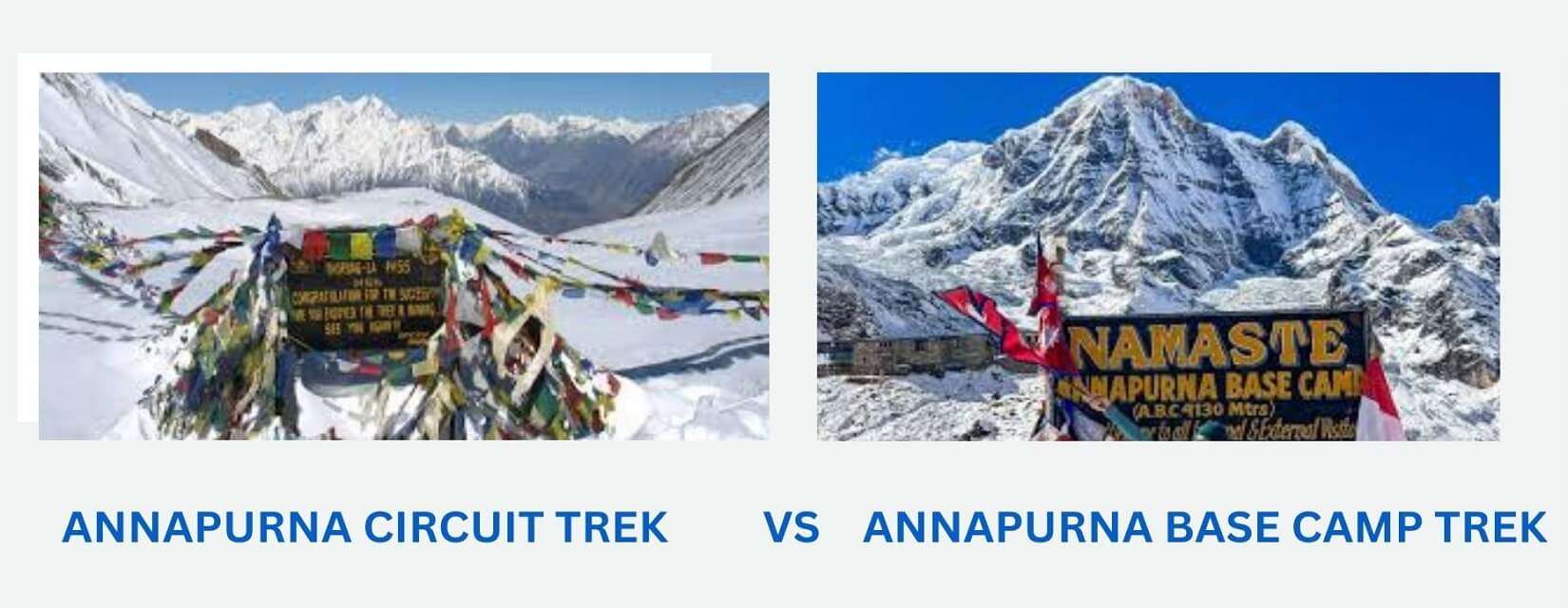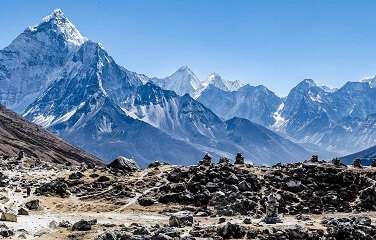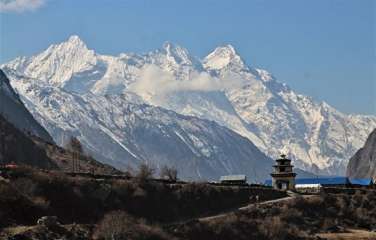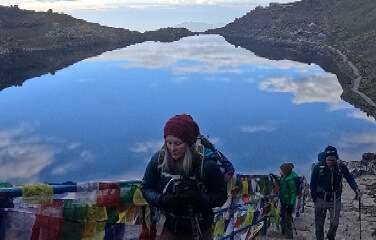Annapurna Base Camp (ABC) Trek:

- Starting Point: The trek typically begins at Nayapul, a short drive from Pokhara, or from a nearby point like Phedi or Kimche.
- Ending Point: The trek usually ends at Nayapul or another nearby point, with a drive back to Pokhara.
- Elevation Range: The trek ranges from 1,070 meters (Nayapul) to 4,130 meters (Annapurna Base Camp).
- Route Length: Approximately 70-110 km, depending on the starting and ending points.
- Duration: 7 to 12 days.
- Key Stops: Ghandruk, Chomrong, Dovan, Deurali, Machhapuchhre Base Camp (MBC), Annapurna Base Camp (ABC).
Annapurna Circuit Trek:

- Starting Point: The traditional start is Besisahar, but many trekkers now begin from Syange, Jagat, or Dharapani to shorten the route.
- Ending Point: Jomsom, Tatopani, or Naya Pul, depending on the route chosen.
- Elevation Range: The trek ranges from 760 meters (Besisahar) to 5,416 meters (Thorong La Pass).
- Route Length: Approximately 160-230 km, depending on variations and transportation choices.
- Duration: 14 to 21 days.
- Key Stops: Chame, Pisang, Manang, Yak Kharka, Thorong Phedi, Muktinath, Kagbeni, Marpha, Tatopani.
Scenery and Natural Beauty

Annapurna Base Camp (ABC) Trek:
The ABC trek offers a direct and intimate experience with the towering peaks of the Annapurna range. The trail passes through diverse landscapes, including terraced fields, lush rhododendron forests, and alpine meadows. The highlight is reaching Annapurna Base Camp, where you are surrounded by an amphitheater of peaks, including Annapurna I (8,091 meters), Machhapuchhre (6,993 meters), Hiunchuli (6,441 meters), and others. The trek is known for its breathtaking sunrises, particularly from Poon Hill if included in the itinerary.
Key Scenic Highlights:
- Rhododendron forests in full bloom during spring.
- The picturesque village of Ghandruk.
- Close-up views of Annapurna and Machhapuchhre.
- The natural amphitheater at Annapurna Base Camp.
Annapurna Circuit Trek:
The Annapurna Circuit is famed for its diversity of landscapes, ranging from subtropical forests and rice paddies to the arid, desert-like landscapes of the Upper Mustang region. The trek offers panoramic views of the Annapurna range, Dhaulagiri, Manaslu, and other peaks. The Thorong La Pass at 5,416 meters is the highest point of the trek, offering a stunning view of the surrounding mountains. The trek also passes through deep gorges, particularly the Kali Gandaki Gorge, one of the world’s deepest.
Key Scenic Highlights:
- Panoramic views from Thorong La Pass.
- The unique landscape and culture of the Manang Valley.
- The Kali Gandaki Gorge, is the world's deepest gorge.
- Views of Annapurna II, III, IV, Gangapurna, and Tilicho Peak.
Cultural Experiences

Annapurna Base Camp (ABC) Trek:
The ABC trek takes you through villages predominantly inhabited by the Gurung and Magar communities. Ghandruk, in particular, is a significant Gurung village known for its rich culture and traditions. The trek offers opportunities to learn about the lifestyle, customs, and traditions of these communities. The presence of Buddhist chortens and prayer flags also adds a spiritual dimension to the journey.
Cultural Highlights:
- The traditional Gurung village of Ghandruk.
- Magar villages with their unique traditions.
- Interaction with local communities and learning about their way of life.
- Buddhist prayer flags, chortens, and monasteries along the route.
Annapurna Circuit Trek:
The Annapurna Circuit offers a broader cultural experience, taking you through a variety of ethnic communities, including Gurung, Thakali, and Tibetan Buddhists. The Manang Valley has a distinct Tibetan Buddhist culture, with monasteries, chortens, and prayer wheels. The village of Kagbeni, a gateway to Upper Mustang, has a medieval atmosphere with its old monasteries and mud-brick houses. The trek also passes through Muktinath, a significant pilgrimage site for both Hindus and Buddhists.
Cultural Highlights:
- Tibetan Buddhist culture in the Manang Valley.
- The ancient village of Kagbeni.
- Muktinath Temple, a sacred site for both Hindus and Buddhists.
- The unique Thakali culture in Jomsom and Marpha.
Difficulty Level
Annapurna Base Camp (ABC) Trek:
The ABC trek is moderately difficult. The trail involves several steep ascents and descents, especially as you approach Chomrong and Deurali. The altitude at Annapurna Base Camp (4,130 meters) is lower compared to the Annapurna Circuit, reducing the risk of acute mountain sickness (AMS). However, trekkers still need to acclimatize properly and maintain a steady pace. The trek is suitable for beginners with a reasonable level of fitness.
Difficulty Factors:
- Steep ascents and descents, particularly at Chomrong.
- Potential altitude-related issues at Annapurna Base Camp.
- Moderate level of physical fitness required.
Annapurna Circuit Trek:

The Annapurna Circuit is more challenging due to its length, elevation gain, and the crossing of Thorong La Pass at 5,416 meters. The long duration and high altitude require good physical fitness, proper acclimatization, and mental endurance. The pass is often snow-covered, especially in winter, making the crossing more difficult. AMS is a concern on this trek, particularly when ascending from Manang to Thorong La.
Difficulty Factors:
- High altitude and the risk of AMS, especially at Thorong La Pass.
- Long trekking days and a demanding route.
- Steep ascent to Thorong La Pass and descent to Muktinath.
- Requires good physical fitness and prior trekking experience.
Duration and Itinerary

Annapurna Base Camp (ABC) Trek:
The ABC trek typically takes 7 to 12 days, depending on the starting and ending points, acclimatization needs, and side trips. A popular itinerary includes a visit to Poon Hill for sunrise views before heading to Annapurna Base Camp. This trek is often combined with a Ghorepani-Poon Hill loop, adding a few days to the journey.
Sample Itinerary (11 Days):
Day 1: Pokhara to Nayapul, trek to Tikhedhunga.
Day 2: Trek to Ghorepani.
Day 3: Poon Hill sunrise, trek to Tadapani.
Day 4: Trek to Chomrong.
Day 5: Trek to Dovan.
Day 6: Trek to Deurali.
Day 7: Trek to Annapurna Base Camp.
Day 8: Trek back to Bamboo.
Day 9: Trek to Jhinu Danda (hot springs).
Day 10: Trek to Nayapul, and drive to Pokhara.
Day 11: Pokhara departure.
Annapurna Circuit Trek:
The Annapurna Circuit trek takes 14 to 21 days, depending on the starting and ending points, acclimatization, side trips, and transportation options. With road construction shortening parts of the trail, some trekkers skip sections using jeeps or buses. A side trip to Tilicho Lake or Nar Phu Valley adds extra days.
Sample Itinerary (18 Days):

Day 1: Drive from Kathmandu to Besisahar.
Day 2: Trek to Jagat.
Day 3: Trek to Dharapani.
Day 4: Trek to Chame.
Day 5: Trek to Pisang.
Day 6: Trek to Manang.
Day 7: Acclimatization day in Manang.
Day 8: Trek to Yak Kharka.
Day 9: Trek to Thorong Phedi.
Day 10: Cross Thorong La Pass, trek to Muktinath.
Day 11: Trek to Kagbeni.
Day 12: Trek to Marpha.
Day 13: Trek to Kalopani.
Day 14: Trek to Tatopani (hot springs).
Day 15: Trek to Ghorepani.
Day 16: Poon Hill sunrise, trek to Nayapul.
Day 17: Drive to Pokhara.
Day 18: Pokhara departure.
Accommodation and Food
Annapurna Base Camp (ABC) Trek
As you ascend, food becomes simpler, but it is still nutritious and suitable for trekkers. Typical meals include dal bhat (rice with lentils), noodles, fried rice, and momo (dumplings). Western dishes like pasta, pizza, and pancakes are available in some places, though they may be less common or more expensive as you approach higher altitudes.
Accommodation and Food Highlights:
- Ghandruk and Chomrong: Offer better-quality lodges with hot showers, Wi-Fi, and a variety of food options.
- Machhapuchhre Base Camp (MBC) and Annapurna Base Camp (ABC): The lodges here are basic, with communal dining areas and limited menus, but the views make up for it.
- Dietary Considerations: Vegetarian meals are widely available and recommended, as meat storage can be an issue at higher altitudes.
Annapurna Circuit Trek:
The Annapurna Circuit offers a wider variety of accommodations due to its length and the diversity of the regions it passes through. The trek starts with basic teahouses in the lower regions, but as you move into the more developed areas like Manang and Jomsom, the quality of accommodation improves. The lodges in Manang, for example, are known for offering more comfort, including attached bathrooms in some places. Food variety is extensive in the lower sections, but like the ABC trek, the menu becomes more limited at higher elevations, especially near Thorong La Pass.
Accommodation and Food Highlights:
- Manang: A well-developed trekking hub with bakeries, Wi-Fi, and better accommodations.
- Thorong Phedi and High Camp: Accommodations are basic and often crowded, especially during peak season.
- Jomsom and Marpha: Known for comfortable lodges and the famous apple products of Marpha, including apple pie and apple cider.
- Dietary Considerations: As with the ABC trek, vegetarian meals are recommended at higher altitudes.
Best Time to Trek

Annapurna Base Camp (ABC) Trek:
The best time to trek to Annapurna Base Camp is during the pre-monsoon (spring) and post-monsoon (autumn) seasons.
Spring (March to May): This is one of the most popular times for the ABC trek. The weather is generally stable, and the rhododendron forests are in full bloom, offering vibrant colors along the trail. Temperatures are moderate, making for comfortable trekking conditions.
Autumn (September to November): Another ideal season, with clear skies and excellent visibility of the mountains. The weather is cool but not too cold, and the chances of rainfall are minimal.
Less Ideal Seasons:
Winter (December to February): While trekking is possible, expect cold temperatures and potential snowfall, particularly near Annapurna Base Camp. Some teahouses may close due to the cold.
Monsoon (June to August): The trail is wet and muddy, with frequent rain and leeches in the lower sections. However, the lush green landscapes can be beautiful if you don’t mind the rain.
Annapurna Circuit Trek:
The Annapurna Circuit also sees its best conditions during the spring and autumn seasons.
Spring (March to May): This season offers warmer temperatures and blooming rhododendrons, especially in the lower regions. Higher elevations, like Thorong La, may still have some snow, but the pass is usually clear by late spring.
Autumn (September to November): The most popular time for the Annapurna Circuit, with clear skies, mild temperatures, and less chance of snow at Thorong La Pass. The visibility of the mountains is excellent, making it ideal for photography.
Less Ideal Seasons:
Winter (December to February): The circuit is challenging during winter due to heavy snowfall, particularly at Thorong La Pass, which may be impassable. Only experienced trekkers should attempt the circuit in these conditions.
Monsoon (June to August): The lower regions of the circuit experience heavy rainfall, leading to landslides and muddy trails. However, the northern section (Manang to Muktinath) lies in the rain shadow of the Himalayas, making it drier and more suitable for trekking during this season.
Permits and Regulations
Annapurna Base Camp (ABC) Trek:
For the ABC trek, you need two permits:
- Annapurna Conservation Area Permit (ACAP): Required for entry into the Annapurna Conservation Area.
- Trekkers’ Information Management System (TIMS) Card: Required for safety tracking of trekkers in the region.
- Both permits can be obtained in Kathmandu or Pokhara from the Nepal Tourism Board or authorized trekking agencies.
Annapurna Circuit Trek:
- The Annapurna Circuit also requires the ACAP and TIMS permits. However, if you plan to take a side trip to the restricted areas like Nar Phu Valley or Tilicho Lake, you will need additional permits:
- Nar Phu Valley Restricted Area Permit: Required for entering the restricted Nar Phu Valley.
- Tilicho Lake: While no special permit is needed, the trail can be challenging and requires proper preparation.
- Permits are checked at various points along both treks, so carrying them is mandatory.
Costs and Budget Considerations
Annapurna Base Camp (ABC) Trek:
The cost of the ABC trek can vary depending on factors such as accommodation standards, meals, guide and porter fees, and transportation. On average:
- Permits: ACAP ($30) + TIMS Card ($10-$20).
- Accommodation: $5 to $20 per night, depending on location and amenities.
- Meals: $5 to $10 per meal.
- Guide and Porter: A guide costs around $25-$30 per day, and a porter costs $15-$20 per day.
- Total Estimated Cost (10 Days):
- Budget: $400-$700 (excluding international flights).
- Mid-Range: $700-$1,000.
Annapurna Circuit Trek:

The Annapurna Circuit generally requires a larger budget due to its longer duration. Costs include:
- Permits: ACAP ($30) + TIMS Card ($10-$20).
- Accommodation: $5 to $30 per night, with more expensive options in Manang and Jomsom.
- Meals: $5 to $10 per meal, with higher costs at higher altitudes.
- Guide and Porter: Same as ABC trek, though you might need them for more days.
- Total Estimated Cost (18 Days):
- Budget: $600-$1,200 (excluding international flights).
- Mid-Range: $1,000-$1,500.
Environmental and Ethical Considerations
Annapurna Base Camp (ABC) Trek:
The ABC trek passes through the Annapurna Conservation Area, which is a protected area. Trekkers are encouraged to minimize their environmental impact by:
- Using refillable water bottles and water purification tablets instead of buying bottled water.
- Disposing of waste properly, including carrying out non-biodegradable items.
- Respecting local customs and traditions, particularly in religious sites.
Annapurna Circuit Trek:
The longer duration and variety of environments in the Annapurna Circuit mean that trekkers can have a significant impact on local ecosystems. Key considerations include:
- Supporting teahouses and lodges that follow sustainable practices.
- Avoiding the use of plastic as much as possible, especially in remote areas where waste disposal is a challenge.
- Being mindful of cultural sensitivities, particularly in Buddhist villages and pilgrimage sites like Muktinath.
Wildlife and Flora
Annapurna Base Camp (ABC) Trek:
The ABC trek is rich in flora, especially during spring when the rhododendron forests are in bloom. The lower regions are home to a variety of birds, including the colorful danphe (Himalayan monal), Nepal’s national bird. As you ascend, you may encounter langur monkeys, deer, and possibly the elusive snow leopard at higher elevations.
Annapurna Circuit Trek:
The Annapurna Circuit offers a broader range of ecosystems, from subtropical forests to alpine regions. The Manang Valley and surrounding areas are home to blue sheep, Himalayan tahr, and occasionally snow leopards. Birdlife is abundant, with species like the golden eagle and Himalayan griffon frequently seen. The circuit also offers unique flora, including medicinal plants and alpine flowers.
Side Trips and Extensions
Annapurna Base Camp (ABC) Trek:
- Poon Hill: A popular side trip for sunrise views, adding 2-3 days to the trek.
- Jhinu Danda: Known for its natural hot springs, a perfect place to relax after the trek.
- Mardi Himal Trek: This can be combined with the ABC trek for those wanting a less crowded route with great views.
Annapurna Circuit Trek:
- Tilicho Lake: A challenging but rewarding side trip to one of the highest lakes in the world.
- Nar Phu Valley: A detour to a remote and culturally rich valley, requiring a special permit.
- Upper Mustang: Though it requires a separate permit and significant additional time, this trek extends into a region with a distinct Tibetan culture and landscape.
Conclusion: Which Trek to Choose?

Choosing between the Annapurna Base Camp trek and the Annapurna Circuit trek depends on your preferences, time, fitness level, and the type of experience you seek.
For those with limited time and who want a more focused experience with spectacular views of the Annapurna massif, the ABC trek is ideal. It offers a more intimate encounter with the mountains and is less physically demanding.
For those with more time and a desire to experience a wide variety of landscapes and cultures, the Annapurna Circuit trek is the better option. It’s a more challenging trek but rewards with a deeper immersion in the region’s natural and cultural diversity.
Both treks offer incredible experiences, but the choice ultimately depends on what kind of adventure you’re looking for. Whether it’s the amphitheater of peaks at Annapurna Base Camp or the thrill of crossing Thorong La Pass, the Annapurna region promises an unforgettable journey through some of the most stunning landscapes in the world.





